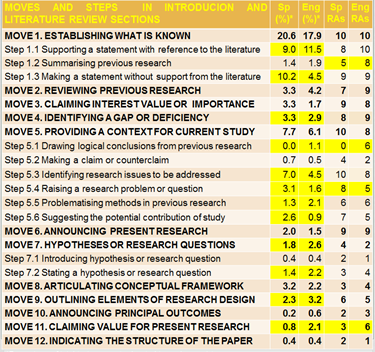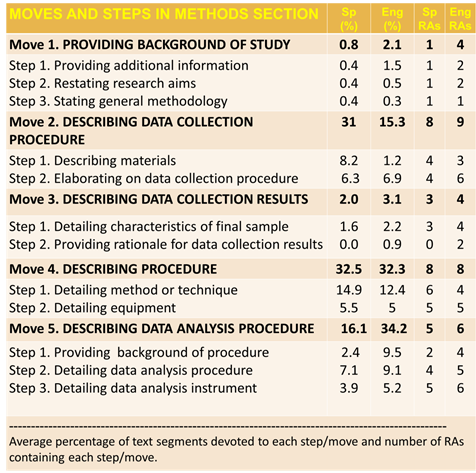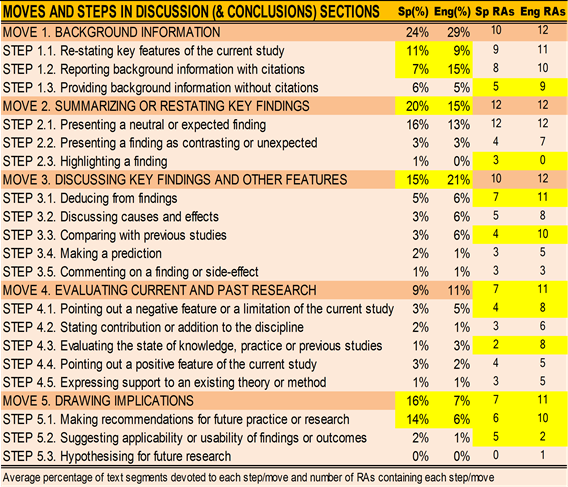Cross-cultural Studies > Preliminary Cross-cultural results
The major milestone resulting from the analyses of a sufficient sample of the RAs in the EXEMPRAES Comparable Corpora was the development of a workable coding protocol and method (Moreno 2014a; Moreno and Swales, 2018) and a valid coding scheme for each section of the RA (Burgess 2014; Gea-Valor 2014; Martín 2014; and Moreno 2014b). In 2014, the analyses of 12 pairs yielded the following preliminary cross-cultural results, organised by RA section.
Introductions (and Literature Reviews) sections

(Taken from Burgess, 2014)
- While the two groups of texts are relatively similar in terms of move structure, differences at the step level suggest that authors adopt strategies tailored to the needs of either international or national audiences.
- In those moves and steps which optionally involve referencing the research literature, the authors of the Spanish texts are marginally less likely to cite sources.
- When contextualising their research, the authors of the English texts use a wider range of strategies.
- There is only a small difference in the proportion of text segments devoted to gap or deficiency identification between the two sets of RAs. This suggests that Spanish authors may have adopted rhetorical strategies associated with international publications in English (Burgess, 2014).
Methods sections
- Move 4, ‘Describing the procedure,’ is the most relevant one in both corpora given the main communicative function of the Methods section, which is to provide a detailed account of the research carried out so it can be replicated.
- However, there are significant differences in the frequency of use of other moves, such as moves 2, ‘Describing data collection procedure,’ and 5, ‘Describing data analysis procedure,’ revealing the influence of the publication context variable in the rhetorical structure of this section (Gea Valor, 2014).

(Taken from Gea-Valor, 2014)
Results (and Discussions) sections

(Taken from Martín-Martín, 2014)
- There is a great deal of similarity across both groups of texts, though some degree of divergence is also observed.
- Spanish writers tend to omit specific comments on the meaning of the results or the data presented in tables and figures, considering them self-standing elements that speak for themselves,
- Writers in English tend to put more effort into discussing the contents of tables and figures (Martín-Martín, 2014).
Discussion and/or Closing sections
- The results show apparent differences across the Spanish and English samples at the move level. More significant differences, however, can be found at the step level within all moves.
- Interestingly, fewer RAs in English include citations when providing background information.
- More RAs in Spanish highlight specific results when summarising or restating key findings.
- More RAs in English include deductions and comparisons with previous studies when discussing key findings and other features.
- More RAs in English point out negative features or limitations of the current study and evaluate the state of knowledge, practice or previous studies when evaluating research.
- When drawing implications, more RAs in English include recommendations for future practice or research, while more RAs in Spanish suggest the applicability of results or the usability of findings or outcomes.

(Taken from Moreno, 2014)
Conclusion and implications
- Despite the small size of the sample in our preliminary studies, the results suggest that the publication context variable affects the rhetorical structure of all RA sections. This has clear implications for multilingual scholars and could lead to the creation of ERPP resources specifically designed for Spanish post-doctoral researchers.
- Analysing and annotating all the pairs in the EXEMPRAES Comparable Corpora using this method will enable us to provide more robust results on the similarities and differences in the rhetorical structure of RAs published in English-medium journals versus those published in Spanish-medium journals.
- Additionally, identifying text fragments that express similar specific communicative functions in highly comparable rhetorical contexts across the two languages opens the possibility of further comparisons of text features at the propositional and metadiscourse levels.
- These comparisons will be facilitated by the EXEMPRAES Corpus, an online application created during the present project to transfer our cross-cultural results (Moreno & Anthony, 2014).
